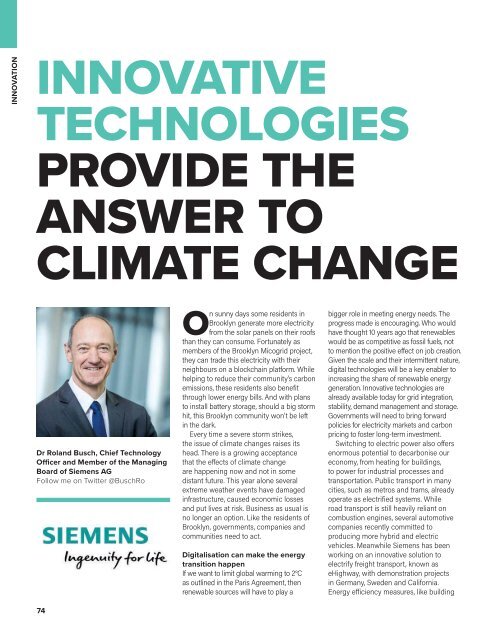Climate Action 2017-2018
You also want an ePaper? Increase the reach of your titles
YUMPU automatically turns print PDFs into web optimized ePapers that Google loves.
INNOVATION<br />
INNOVATIVE<br />
TECHNOLOGIES<br />
PROVIDE THE<br />
ANSWER TO<br />
CLIMATE CHANGE<br />
Dr Roland Busch, Chief Technology<br />
Officer and Member of the Managing<br />
Board of Siemens AG<br />
Follow me on Twitter @BuschRo<br />
74<br />
On sunny days some residents in<br />
Brooklyn generate more electricity<br />
from the solar panels on their roofs<br />
than they can consume. Fortunately as<br />
members of the Brooklyn Micogrid project,<br />
they can trade this electricity with their<br />
neighbours on a blockchain platform. While<br />
helping to reduce their community’s carbon<br />
emissions, these residents also benefit<br />
through lower energy bills. And with plans<br />
to install battery storage, should a big storm<br />
hit, this Brooklyn community won’t be left<br />
in the dark.<br />
Every time a severe storm strikes,<br />
the issue of climate changes raises its<br />
head. There is a growing acceptance<br />
that the effects of climate change<br />
are happening now and not in some<br />
distant future. This year alone several<br />
extreme weather events have damaged<br />
infrastructure, caused economic losses<br />
and put lives at risk. Business as usual is<br />
no longer an option. Like the residents of<br />
Brooklyn, governments, companies and<br />
communities need to act.<br />
Digitalisation can make the energy<br />
transition happen<br />
If we want to limit global warming to 2°C<br />
as outlined in the Paris Agreement, then<br />
renewable sources will have to play a<br />
bigger role in meeting energy needs. The<br />
progress made is encouraging. Who would<br />
have thought 10 years ago that renewables<br />
would be as competitive as fossil fuels, not<br />
to mention the positive effect on job creation.<br />
Given the scale and their intermittent nature,<br />
digital technologies will be a key enabler to<br />
increasing the share of renewable energy<br />
generation. Innovative technologies are<br />
already available today for grid integration,<br />
stability, demand management and storage.<br />
Governments will need to bring forward<br />
policies for electricity markets and carbon<br />
pricing to foster long-term investment.<br />
Switching to electric power also offers<br />
enormous potential to decarbonise our<br />
economy, from heating for buildings,<br />
to power for industrial processes and<br />
transportation. Public transport in many<br />
cities, such as metros and trams, already<br />
operate as electrified systems. While<br />
road transport is still heavily reliant on<br />
combustion engines, several automotive<br />
companies recently committed to<br />
producing more hybrid and electric<br />
vehicles. Meanwhile Siemens has been<br />
working on an innovative solution to<br />
electrify freight transport, known as<br />
eHighway, with demonstration projects<br />
in Germany, Sweden and California.<br />
Energy efficiency measures, like building












